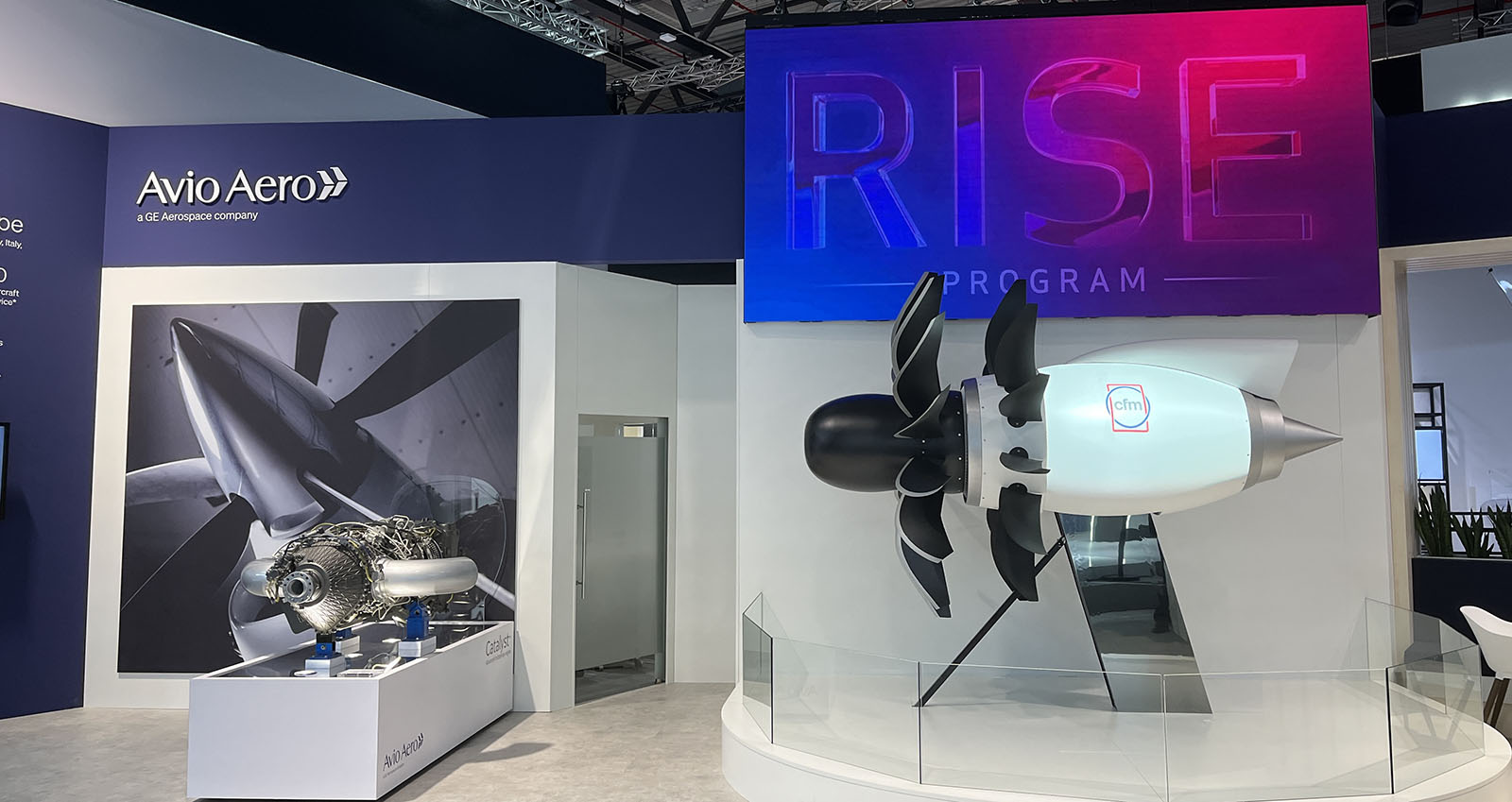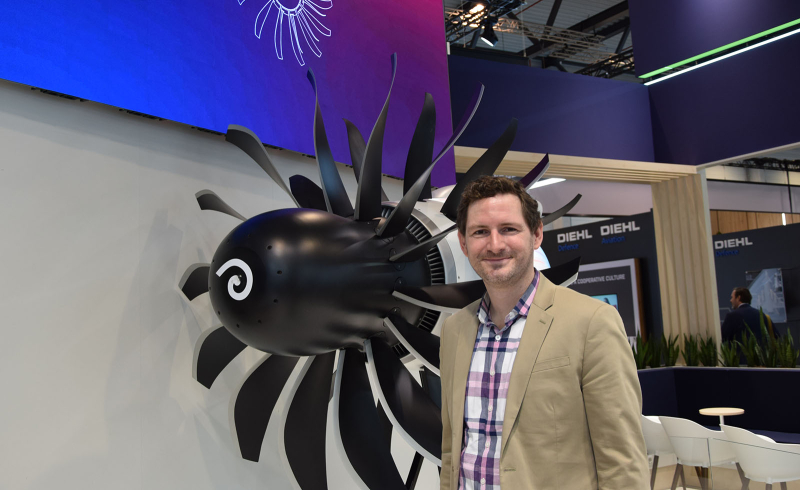Humans
Homecoming
At the last ILA Berlin airshow, GE Aerospace's engineer Roman Seele returned to his roots to invent the future of flight.
Jun 2024
Buoyed by helium and floating above the crowds at Berlin’s Schönefeld Airport, the German-built, 75-meter-long Zeppelin NT airship was one of many awe-inspiring aircraft on display at the 2002 Internationale Luft- und Raumfahrtausstellung (ILA) Berlin Air Show. Yet Roman Seele, then a 21-year-old college student attending his first aviation exhibition, was more blown away by something he encountered inside the exhibition halls: the cross section of a modern airplane engine.
“The jet engine had been cut open to reveal its interior,” he recalls. “I thought, Look at how complex this is. This is crazy!” While Seele says he had always found mechanical and civil engineering designs to be relatively straightforward, “this engine was so complex that I couldn’t intuitively understand it. I just thought, I want to know how this works. That’s when I decided to study aerospace engineering.”
Flash forward a couple of decades later and Seele doesn’t just understand jet engines — he’s helping to reinvent them. In early June, when he attended ILA Berlin for a second time, he did so as the engineering leader for GE Aerospace’s future of flight and sciences team in Munich, Germany. And he was there to tell others, including aspiring young engineers, about the design and capabilities of an engine that will advance well beyond the one that originally inspired him.
At this month’s ILA Berlin, Seele with his GE Aerospace and Avio Aero colleagues presented a half-scale replica of the pioneering Open Fan engine they’re developing through the Revolutionary Innovation for Sustainable Engines (RISE) program. Unveiled in 2021 by CFM International, a 50/50 joint company between GE Aerospace and Safran Aircraft Engines, the RISE program is advancing technologies to support flight that is 20% more fuel efficient with 20% lower carbon emissions than current commercial engines.
“We are working very hard at making flight more sustainable, at getting more efficiency out of a jet engine,” he says. “It was exciting to be able to return to the air show in a leadership role, where I’m in a position to talk publicly about all the work we are doing as a team, and how inspiring it is to be working on this program.”
Seele grew up in East Berlin and was a young boy when the city’s infamous Wall came down. After majoring in aerospace engineering at the Technische Universität Berlin, he moved overseas to study at the University of Arizona, earning his master’s degree in 2008. Career opportunities and family kept him in the United States for the next 17 years.
At first Seele worked as a research engineer, investigating aircraft wing aerodynamics at the University of Arizona and then the California Institute of Technology. A chance to focus on airplane engines brought him to Cincinnati and GE Aerospace in 2013. “I dove right in, working on engine operability for three years, and I was lucky enough to be part of a number of exciting tests, including the flight test for the Passport turbofan,” Seele says.
Seele moved into hybrid electric systems in 2016, eventually managing the company’s proposal to partner with NASA on the Electrified Powertrain Flight Demonstration (EPFD) program. When GE Aerospace was awarded the contract, in 2021, he was selected to oversee it, guiding efforts to develop a megawatt-class hybrid electric powertrain for ground and flight testing this decade. At that point, he says, only a once-in-a-lifetime opportunity could have lured him away from seeing the EPFD project to its completion. But that’s exactly what happened in 2023 when Seele, his wife, and their two sons, moved to Garching, just outside of Munich, so that he could take on a newly created role to lead the Munich engineering team.
The team is helping push forward new technologies related to nearly every aspect of next-generation flight. “It’s a nice challenge to bring all of these technologies and people together, and I really like working with such a big, international team,” he says. “We’re a close-knit group, everyone with their own role and working very deeply within their disciplines.”
“If something doesn’t work, we pivot, and move on to try something else. That’s the coolest thing you can ever get to do as an engineer”
While Seele and his team support various projects, including the Catalyst engine and several Europe-based initiatives for the Clean Aviation program, much of their work relates to developing RISE program engine technologies. “Many people talk about the RISE project’s Open Fan, which is very visible and a big, important selling piece,” he says. “But we’re working on so many other exciting technologies too, including hybrid technologies, new thermal designs, and a new compact core that’s much smaller than engine cores that have come before.”
Innovation and reducing emissions, along with safety and reliability, are the aims that guide their efforts. “We have a leadership team that empowers us to try new ideas,” he says. “If something doesn’t work, we pivot, and move on to try something else. That’s the coolest thing you can ever get to do as an engineer.”
The Munich-based engineering team is rapidly growing, with Seele looking to fill more positions in the coming months. “In interviews, candidates ask me what I like best about working at GE Aerospace, and while it may sound cheesy, I say it’s the people,” he says. “I work with people who are immensely smart, who care a lot about their work, and who want to succeed as a team. When we succeed, we succeed together. And when something doesn’t go as planned, it’s not about what anyone did — it’s about understanding what happened and then improving it. That’s just a fun organization.”
Meanwhile, as his wife and sons are settling in and working to perfect their German, Seele is rediscovering things he’s missed since being away from his home country. Topping the list is seeing his family and friends, most of whom are still in Berlin. “And honestly, the other thing I love here is the food, especially the bread,” he says. “My family, German bakeries, using trains, and the chance to simply walk around more to enjoy fresh air — it has all been awesome.”
The original version of this story is by GE Aerospace blog.






